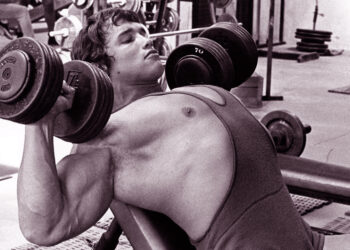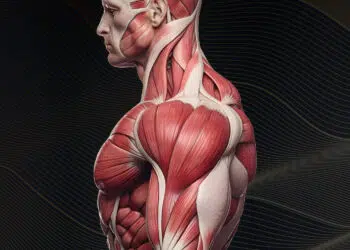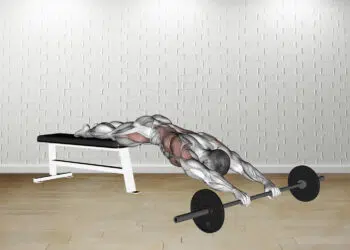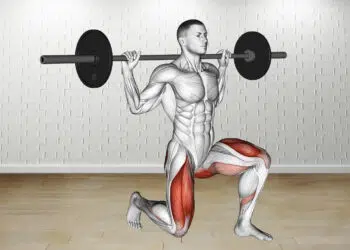The seated dumbbell overhead press is a compound movement which builds muscle and strength in the anterior deltoids, or front deltoids. It’s a very effective free weight movement and by using dumbbells you develop stabilizer muscles and unilateral (Affecting each side) strength as a result.
The benefits make this exercise an ideal choice and anyone at any level of training can do it safely for muscle and strength building gains. But, if you’re a beginner it’s highly recommended to start light and practice good form as there is an element of risk associated with this movement if not careful to maintain proper form.
But, the seated dumbbell overhead press is a must for maximum shoulder development.
Seated Dumbbell Overhead Press: Why It’s Your Next Favorite Exercise
Beyond just muscle development, the seated version of the dumbbell overhead press comes with its own set of advantages. When seated, your lower back is supported, allowing for better posture and reduced strain. Let’s explore the magic behind this movement!
Anatomy of the Movement
A Seated Dumbbell Overhead Press isn’t merely lifting weights above your head. It’s an art, synchronizing multiple muscle groups:
- Deltoids: Your main shoulder muscles.
- Triceps: The muscle at the back of your upper arm.
- Upper Pecs: The top part of your chest muscles.
Seated Dumbbell Overhead Press: Why It’s Your Next Favorite Exercise
Beyond just muscle development, the seated version of the dumbbell overhead press comes with its own set of advantages. When seated, your lower back is supported, allowing for better posture and reduced strain. Let’s explore the magic behind this movement!
Level Up Your Fitness: Join our 💪 strong community in Fitness Volt Newsletter. Get daily inspiration, expert-backed workouts, nutrition tips, the latest in strength sports, and the support you need to reach your goals. Subscribe for free!
Anatomy of the Movement
A Seated Dumbbell Overhead Press isn’t merely lifting weights above your head. It’s an art, synchronizing multiple muscle groups:
- Deltoids: Your main shoulder muscles.
- Triceps: The muscle at the back of your upper arm.
- Upper Pecs: The top part of your chest muscles.
Benefits Beyond Muscles
- Improved Posture: The seated position encourages a straight back.
- Increased Shoulder Stability: Regular training promotes joint health.
- Versatility: Suitable for both beginners and pros!
How to Perfect the Seated Dumbbell Overhead Press
Embarking on the journey to master the Seated Dumbbell Overhead Press? Here’s a step-by-step guide to ensure you nail it right from the start. Remember, it’s not just about lifting weights; it’s about doing it right.
Setting up the Stage
- Choosing the Right Seat: Opt for a bench that has a back support to help keep your posture intact. Make sure it’s stable and at a height where your feet touch the ground fully.
- Picking the Dumbbells: If you’re a beginner, start with a weight that feels challenging but manageable. You should be able to do at least 8 reps without compromising form.
Positioning Yourself
- Sitting Down: Position yourself so that your back is flat against the bench’s support. This prevents unnecessary arching and promotes a straight posture.
- Grip: Hold the dumbbells with a full grip (thumb wrapping around the handle) and keep your wrists straight.
- Starting Position: Begin with the dumbbells at shoulder height, palms facing forward. Your elbows should be slightly ahead of your body, not flared out to the sides.
Executing the Press
- Engage Your Core: Before you press, tighten your core. This will stabilize your body during the lift.
- The Ascent: Press the dumbbells upward in a controlled motion until your arms are fully extended. Do not let the dumbbells touch at the top.
- Pause: At the top of the movement, pause for a moment to feel the contraction in your shoulders and triceps.
- The Descent: Slowly lower the dumbbells back to the starting position, maintaining control throughout.
Watch how to do the seated dumbbell overhead press:
Common Pitfalls and How to Avoid Them
- Arching the Back: Ensure your lower back remains in contact with the bench at all times. Engaging your core helps with this.
- Using Momentum: Avoid using a bouncing motion at the bottom of the rep to push the weights up. The movement should be smooth and controlled.
- Flaring Elbows: Keep your elbows slightly in front of your body throughout the press to protect your shoulders.
Breathing Technique
Breathe in as you lower the weights and breathe out forcefully as you press them up. This rhythm not only helps with stamina but also provides an internal brace for your core during the movement.
Getting Started: Tips & Tricks
Eager to begin? Before you jump in, consider these pointers to get the most out of your workout.
Equipment Choices
Not all dumbbells are created equal. From neoprene to hex, your choice affects your grip and stability.
Setting the Right Posture
A correct posture can make or break your exercise experience. Ensure a straight back and planted feet.
Breathing Techniques
Inhale while lowering, exhale when pushing upwards. This isn’t just hot air—it boosts performance!
Advanced Techniques: Upping Your Game
For those looking to challenge themselves further, here are some advanced tweaks.
Level Up Your Fitness: Join our 💪 strong community in Fitness Volt Newsletter. Get daily inspiration, expert-backed workouts, nutrition tips, the latest in strength sports, and the support you need to reach your goals. Subscribe for free!
Incorporate Pauses
Hold the dumbbells in the overhead position for a few seconds. Feel the burn!
Use Progressive Overload
Gradually increase the weight as your strength improves. Challenge yourself, but be safe.
Mix in Compound Movements
Integrate the seated press with other exercises, like a squat or lunge, for full-body engagement.
Recovery and Aftercare
Work is only half the equation. Recovery is vital.
Stretching for Success
Post-exercise stretches, especially for the shoulder and triceps, enhance flexibility and reduce soreness.
Dietary Support
Proteins and healthy fats aid muscle repair. Don’t forget your greens either!
Regular Rest Periods
Remember, muscles grow during rest, not during workouts. Give them time!
Variations & Tips:
- You can also use a barbell to use the maximum amount of resistance.
- Try different hand positions to stimulate the muscles from a different angle.
- During the negative, only lower your upper arms until parallel to the floor. This keeps your shoulders in a safer position.
- Beginners should start light and work their way up as they become more experienced with the overhead press.
- The seated dumbbell overhead press is a very effective compound exercise for developing the shoulders.
FAQs
Why is the seated version recommended over standing?
The seated position offers better stability and reduces the risk of lower back strain. It allows for more focused muscle engagement.
How often should I incorporate this exercise into my routine?
2-3 times a week is ideal for most people. However, individual needs may vary.
Can beginners attempt the Seated Dumbbell Overhead Press?
Absolutely! Start with lighter weights and progress gradually.
Is there a risk of shoulder injury?
As with all exercises, improper form can lead to injury. Always ensure you’re using the correct technique.
How do I know I’m ready for advanced techniques?
Listen to your body! If you’re comfortably lifting a weight for more than 12 reps, consider upping the ante.
What other exercises complement this one?
The lateral raise, front raise, and bench press are excellent complementary exercises for a full upper body workout.
Conclusion
The Seated Dumbbell Overhead Press, with its myriad of benefits, is a must-add to your workout routine. Whether you’re a novice or a seasoned pro, this exercise offers something for everyone. So, the next time you hit the gym, give it a go! Remember to always prioritize form over weight, and soon enough, you’ll reap the rewards.
Interested in measuring your progress? Check out our strength standards for Bench Press, Squat, Lunge.









Good training tips right there..